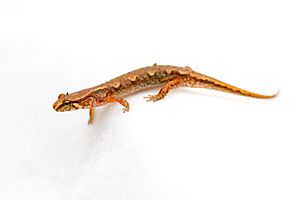Pygmy salamander facts for kids
Quick facts for kids King Pygmy salamander |
|
|---|---|
 |
|
| Conservation status | |
| Scientific classification |
The pygmy salamander (Desmognathus wrighti) is a tiny type of salamander that belongs to the Plethodontidae family. These amazing creatures live only in the southern Appalachian Mountains in the United States, specifically in North Carolina and Tennessee.
Pygmy salamanders are the smallest of the nineteen species in their group, called Desmognathus. Unlike many other amphibians, pygmy salamanders do not have a free-swimming larval stage. This means their young hatch looking like miniature adults, not tadpoles. They are mostly found in high places in spruce and fir tree forests.
Contents
What is a Pygmy Salamander?
The pygmy salamander is known for being very small. It is one of the tiniest salamanders in the world! Its scientific name is Desmognathus wrighti. This species was first named and described by a scientist named King in 1936.
These salamanders have a light-colored belly with a shiny, gold pattern. Their snout is round, and their total body length is usually between 35 and 44 millimeters (about 1.4 to 1.7 inches). Their tail is not flattened like a fin, and it's usually about the same length as their body.
Pygmy salamanders are typically light brown. They often have a dark brown, upside-down "V" shape pattern along their back. This "V" pattern is a classic way to identify them. Their color can also be brick red or yellow. A light stripe from their eye to their jaw helps show they are a type of Desmognathus salamander.
Where Pygmy Salamanders Live
Pygmy salamanders live in specific areas of the southern Appalachian Mountains. You can find them in parts of North Carolina and Tennessee, mainly south of the French Broad River.
In Tennessee, they live in places like the Great Smoky Mountains National Park and the Cherokee National Forest. In North Carolina, they are found in Graham County, near the Tennessee border.
These salamanders prefer to live at high elevations, usually between 1,600 and 2,082 meters (about 5,250 to 6,830 feet) high. They especially like forests with red spruce and Fraser's fir trees. While most are found at higher elevations, some populations can live at lower elevations too, from 950 to 1,400 meters (about 3,100 to 4,600 feet).
Pygmy salamanders like moist places. You can often find them under logs and rocks near streams, in damp leaf litter, or in mossy areas on the forest floor. They are the most land-dwelling species in their group.
Pygmy Salamander Life Cycle and Behavior
Pygmy salamanders have a unique way of reproducing. Males usually become ready to mate by their second or third year, while females are ready by their third year.
During courtship, the male pygmy salamander bites the female. This bite helps special chemicals, called pheromones, get into the female's body. These pheromones are important for mating. After the bite, the male wiggles his tail. The female then turns and puts her chin on his wiggling tail, and they move in a circle.
Next, the male releases a small packet of sperm, called a spermatophore, onto the ground. The female then moves forward and picks up the sperm with her body.
Female pygmy salamanders lay about 8 to 9 eggs. They usually lay their eggs in stream banks where there is wet gravel. The female often stays close to her eggs, coiling her body around them to protect them.
When the eggs are ready to hatch, the embryos push against the egg capsule and rotate until they break free. Pygmy salamander hatchlings are not larvae; they look like tiny versions of the adults. They have gills during their late embryo stages, but these disappear after hatching. When they hatch, their belly is uncolored, but they already have the "V" pattern on their back and the stripe from their eye to their jaw.
Conservation Status
The pygmy salamander was last checked in 2004 and is listed as being of least concern on the IUCN Red List of Threatened Species. This means their population is large, spread out, and not expected to decline quickly.
However, there are still some threats to pygmy salamanders. One major threat is the cutting down of spruce-fir forests where they live. Acid rain is also a problem at high elevations, as it can damage the spruce-fir trees that are part of the pygmy salamander's natural home. Protecting these forests is important for the salamanders' future.


